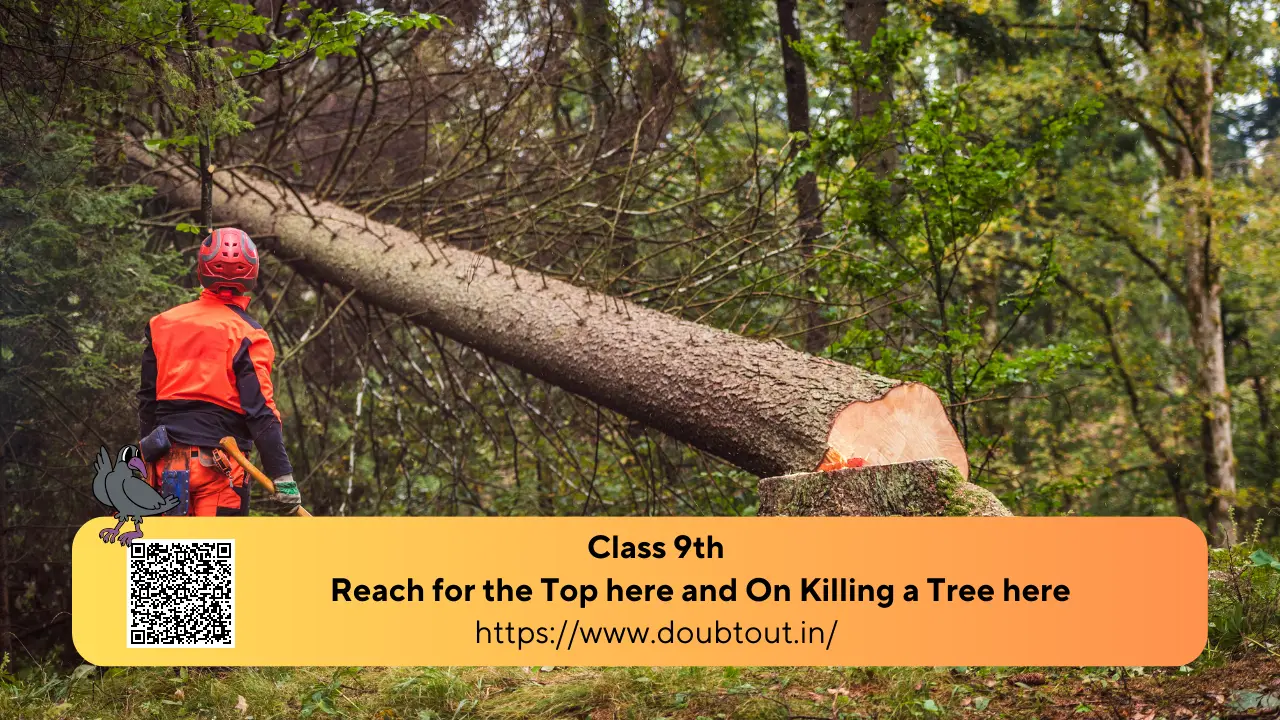
NCERT Solutions for Class 9 English Chapter 7 Reach for the Top here and On Killing a Tree here (Updated Pattern)

Reach for the Top (Prose)
The chapter presents the students with the life and achievements of two inspirational ladies- Santosh Yadav and Maria Sharapova. Santosh Yadav, the only woman in the world to have climbed the mighty Mount Everest twice, hails from India. A patriot and an environmentalist at heart, she tells how she developed the dream of reaching the top of the world – the summit of Mount Everest.
We also are taken through Maria Sharapova’s journey of becoming the world’s number one tennis player. The chapter talks about her struggles and how she never let anything come in between her and her goal.
Thinking about the Text
I. Answer these questions in one or two sentences each. (The paragraph numbers within brackets provide clues to the answers.)
Question 1. Why was the ‘holy man’ who gave Santosh’s mother his blessings surprised? (1)
Answer: The ‘holy man’ who gave Santosh’s mother his blessings was surprised because Santosh’s grandmother sought that Santosh’s mother be blessed with a daughter. This was quite astonishing for the holy man because people mostly seek blessings for having a son.
Question 2. Give an example to show that even as a young girl, Santosh was not ready to accept anything unreasonable. (2)
Answer: Even as a young girl, Santosh was not ready to accept anything unreasonable. She was not content with her place in the traditional way of life and began living life on her own terms from the start. While other girls wore traditional Indian dresses, Santosh used to wear shorts.
Question 3. Why was Santosh sent to the local school? (3)
Answer: Although Santosh’s parents were rich landowners and could have sent her to the best schools, Santosh was sent to the local school because of the prevailing custom in the family.
Question 4. When did she leave home for Delhi, and why? (4)
Answer: She left home for Delhi when she was sixteen because she wanted to get a proper education.
Question 5. Why did Santosh’s parents agree to pay for her schooling in Delhi? What mental qualities of Santosh are brought to light by this incident? (4)
Answer: Santosh’s parents agreed to pay for her schooling in Delhi when she informed them about her plans to earn money by working part-time to pay for her education.
Through this incident, we get to know that Santosh had a very clear goal of getting properly educated no matter what.
II. Answer each of these questions in a short paragraph (about 30 words)
Question 1. How did Santosh begin to climb mountains?
Answer: Kasturba Hostel, where Santosh used to stay during her college days, faced Aravalli Hills. She used to watch the villagers go up the hill and vanish after a while. She decided to check out the mountains herself. She asked the villagers if she could join them, to which they agreed. This is how Santosh began to climb mountains.
Question 2. What incidents during the Everest expedition show Santosh’s concern for her team-mates?
Answer: During the Everest expedition in 1992, Santosh provided special care to a climber who was dying at the South Col. She could not save him, but she managed to save another climber, Mohan Singh, by sharing her oxygen with him.
Question 3. What shows her concern for the environment?
Answer: Santosh collected and brought down 500 kilograms of garbage from the Himalayas on her way back from the 1992 Everest expedition. This shows her concern for the environment.
Question 4. How does she describe her feelings at the summit of Everest?
Answer: She says that it took her some time for the enormity of the moment to sink in. She unfurled the Indian tricolor and held it aloft on the roof of the world.
She tells that the feeling is indescribable to watch the Indian flag flying on top of the world. She felt proud as an Indian.
Question 5. Santosh Yadav got into the record books both times she scaled Mt Everest. What were the reasons for this?
Answer: Santosh Yadav got into the record books both times she scaled Mt Everest. The first time she climbed Mt Everest, she got the record of the youngest woman in the world to achieve the feat. The second time she climbed Mt Everest, she became the only woman to climb Everest twice.
III. Complete the following statements.
1. From her room in Kasturba Hostel, Santosh used to _________________.
2. When she finished college, Santosh had to write a letter of apology to her father because _________________.
3. During the Everest expedition, her seniors in the team admired her _________________ while _________________ endeared her to fellow climbers.
Answer:
1. From her room in Kasturba Hostel, Santosh used to watch villagers from her room, going up the hill and suddenly vanishing after a while.
2. When she finished college, Santosh had to write a letter of apology to her father because she had got herself enrolled at Uttarkashi without his permission.
3. During the Everest expedition, her seniors in the team admired her climbing skills, physical fitness and mental strength, while her concern for others and desire to work together with them endeared her to fellow climbers.
Fitness That Lasts: Ditch the Fad Diets and Build a Sustainable Workout Routine
IV. Pick out words from the text that mean the same as the following words or expressions. (Look in the paragraphs indicated.)
1. took to be true without proof (1):
2. based on reason; sensible; reasonable (2):
3. the usual way of doing things (3):
4. a strong desire arising from within (5):
5. the power to endure, without falling ill (7):
Answer:
1. took to be true without proof: assumed
2. based on reason; sensible; reasonable: rational
3. the usual way of doing things: custom
4. a strong desire arising from within: urge
5. the power to endure, without falling ill: resistance
Part II
Maria Sharapova
Thinking about the Text
Working in small groups of 4–5 students, go back over the two passages on Santosh Yadav and Maria Sharapova and complete the table given below with relevant phrases or sentences.
| Points of Comparison/Contrast | Santosh Yadav | Maria Sharapova |
| 1. Their humble beginning | ||
| 2. Their parents’ approach | ||
| 3. Their will power and strong desire to succeed | ||
| 4. Evidence of their mental toughness | ||
| 5. Their patriotism |
Answer:
| Points of Comparison/Contrast | Santosh Yadav | Maria Sharapova |
| 1. Their humble beginning | She was born in the small village of Joniyawas of Rewari District in Haryana. | “My father was working as much as he could to keep my tennis training going.” |
| 2. Their parents’ approach | But, in line with the prevailing custom in the family, Santosh had to make do with the local village school. | “My father was working as much as he could to keep my tennis training going.” |
| 3. Their will power and strong desire to succeed | “And I was supposed to be in Uttarkashi on the twenty-first. So, I did not go back home; instead, I headed straight for the training.” | “When you come from nothing and you have nothing, then it makes you very hungry and determined…” |
| 4. Evidence of their mental toughness | Equipped with an iron will, physical endurance and an amazing mental toughness, she proved herself repeatedly. | “Instead of letting that depress me, I became more quietly determined and mentally tough.” |
| 5. Their patriotism | “Then I unfurled the Indian tricolour and held it aloft on the roof of the world. The feeling is indescribable. The Indian flag was flying on top of the world. It was truly a spiritual moment. I felt proud as an Indian.” | “My blood is totally Russian. I will play the Olympics for Russia if they want me.” |
Poem On Killing a Tree here
On Killing a Tree (Poem)
The poem ‘On Killing a Tree’ says that even when one cuts a tree, after a few years, it will come back to life. The poet says that one cannot kill a tree simply because it has fed on years of sunlight, air and water. The tree has been nourished by mother earth, and it will take a lot of hard work to actually ‘kill a tree’.
Thinking about the Poem
Question 1. Can a “simple jab of the knife” kill a tree? Why not?
Answer: No, a simple jab of the knife cannot kill a tree because the tree grows with a lot of nutrients and resources. Even if one cuts it, it will sprout again.
Question 2. How has the tree grown to its full size? List the words suggestive of its life and activity.
Answer: The tree has grown to its full size by consuming the earth, feeding upon its crust, absorbing years of sunlight, air and water.
The words suggestive of its life and activity are: absorbing, feeding, rising, consuming and sprouting.
Question 3. What is the meaning of “bleeding bark”? What makes it bleed?
Answer: The “bleeding bark” indicates the idea that the tree has been cut. Just like humans bleed blood when they get wounded, trees release a liquid at the place where they are cut. So, the tree bleeds.
Question 4. The poet says “No” in the beginning of the third stanza. What does he mean by this?
Answer: The poet says “No” in the beginning of the third stanza. It emphasizes that only cutting or chopping the tree will not cease its existence.
Question 5. What is the meaning of “anchoring earth” and “earth cave”?
Answer: The “anchoring earth” means that the earth works as an anchor to protect the tree and saves it from getting uprooted.
“Earth cave” implies the depth of the mother earth where the tree spreads its roots and gets nurtured.
Question 6. What does he mean by “the strength of the tree exposed”?
Answer: He means to say that when one tries to pull out the tree along with its roots which are spread deep inside the earth, one will understand the strength of the tree.
Question 7. What finally kills the tree?
Answer: When the tree is pulled out along with its roots and separated from mother earth, one has to subject it to the scorching sun and let it wither. This will finally kill the tree.




1 Comment